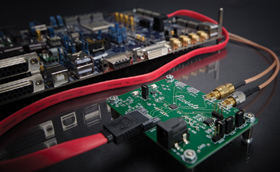First ever all-digital radio transmitter invented
8 April 2015
Electronics Technology
News
Telecoms, Datacoms, Wireless, IoT
Editor's Choice

Technology innovation firm Cambridge Consultants of the UK has successfully completed initial trials of the world’s first fully digital radio transmitter.
Unlike software-defined radio (SDR), it’s not a mixture of analog and digital components, but rather a completely digital radio that can enable new ways of using spectrum intelligently.
According to the company, the latest breakthrough – codenamed Pizzicato – opens the door to a new dynamic way in which the predicted 100 billion IoT (Internet of Things) devices can operate together in a crowded radio spectrum, and will enable the creation of 5G systems with multiple radios and antennas.
The transmitter consists of an integrated circuit outputting a single stream of bits, and an antenna – with no conventional radio parts or digital-to-analog converter. Patented algorithms perform the necessary ultra-fast computations in real time, making it possible for standard digital technology to generate high-frequency radio signals directly.
According to Monty Barlow, director of wireless technology at Cambridge Consultants, the first trial of the technology has created 14 simultaneous cellular base station signals, but more exciting is the potential. “If we’re going to get high-speed broadband to every mobile phone in the world, we’ll need lots of tiny, high-performance radios in those phones,” he points out. “The radios will be squashed together in a way that analog just doesn’t tolerate, whereas a Pizzicato-like digital radio can follow Moore’s Law to smaller size and lower power consumption.
“It could also be programmed to generate almost any combination of signals at any carrier frequencies, nimbly adapting its behaviour in a way that is impossible in conventional radios. It is early days for this technology but we believe radio design has reached a turning point.”
Good radio spectrum is a scarce resource; only low frequencies (1 GHz or lower) propagate well over distance or through walls, so they are in great demand. Greater efficiency requires the use of dynamic or ‘cognitive wireless’ techniques to sense the radio environment and switch parameters on the fly. This could give access to more of the estimated 90% of the allocated spectrum which is not in use at any one time.
Making use of the higher carrier frequencies of 10 GHz and beyond, however, will require techniques such as meshing and beamforming to circumvent the inherently poor range, and the analog parts of radios are becoming an increasing bottleneck.
“Crowding 50 analog radios together on one chip, switching their operational parameters every few microseconds and expecting them to work at 60 GHz is an analog designer’s nightmare,” said Barlow. “With Pizzicato, we have created a glimpse of future disruptive technology – a radio built purely from computing power.”
Further reading:
X-band radar
RF Design
Editor's Choice Telecoms, Datacoms, Wireless, IoT
X-band radar systems, particularly those leveraging beamforming ICs (BFICs), advanced gallium nitride (GaN) and gallium arsenide (GaAs) components, are leading the way in providing the high-performance radar capabilities required for modern defence and surveillance.
Read more...
Achieving lowest cost, scalable and dynamic wireless mesh network installations
CST Electronics
Editor's Choice Telecoms, Datacoms, Wireless, IoT
In many situations it is desirable for sensors to be connected wirelessly in a mesh network as this saves infrastructure and cost since long cabling runs are not required.
Read more...
RFID in aviation: the ultimate solution to baggage mishandling
Osiris Technical Systems
Editor's Choice Telecoms, Datacoms, Wireless, IoT
Creating a solution that enables real-time tracking of airline baggage on a global scale seems like an impossible task when considering the number of airlines, airports, and passengers that flow through and between them.
Read more...
The power of UWB
EBV Electrolink
Editor's Choice Telecoms, Datacoms, Wireless, IoT
Ultra-Wideband, the robust wireless communications technology commonly known as UWB, is such a versatile technology, capable of doing so many different things, that it can be hard to categorise.
Read more...
140 W USB-C PD reference design
Altron Arrow
Electronics Technology
The design has a wide input range of 90 to 264 V AC, 50-60 Hz, and supports an output voltage range of 5 to 28 V (USB-PD 3.1 specification).
Read more...
How will Matter help us meet the smart home promise?
Avnet Silica
Editor's Choice Telecoms, Datacoms, Wireless, IoT
From door locks to fridges, robot vacuum cleaners to security cameras, using Matter should mean consumers only need one app and controller to manage and monitor all the smart devices in their homes, instead of one per ecosystem.
Read more...
Designing a smart wireless industrial sensor
Altron Arrow
Editor's Choice Telecoms, Datacoms, Wireless, IoT
This article provides an overview of wireless standards and assesses the suitability of Bluetooth LE, SmartMesh (6LoWPAN over IEEE 802.15.4e), and Thread/Zigbee (6LoWPAN over IEEE 802.15.4) for use in industrial harsh RF environments.
Read more...
The rise of AI expertise as a new employment trend in South Africa
Editor's Choice News
As artificial intelligence (AI) technology continues to evolve globally, its integration into the South African business landscape is becoming increasingly prominent, and this shift has triggered a surge in demand for AI specialists.
Read more...
Three lessons learned from successful SMEs over the past 27 years
Editor's Choice News
Companies that prioritise employee growth and create a positive work environment tend to have higher employee retention rates and better overall performance.
Read more...
Quectel and iCORP: driving wireless technology
iCorp Technologies
Editor's Choice Telecoms, Datacoms, Wireless, IoT
As the IoT continues to expand, Wi-Fi and Bluetooth are increasingly relied on to deliver secure, robust, short-range connectivity for IoT applications and devices ranging from customer premise equipment to Bluetooth beacons and trackers.
Read more...

